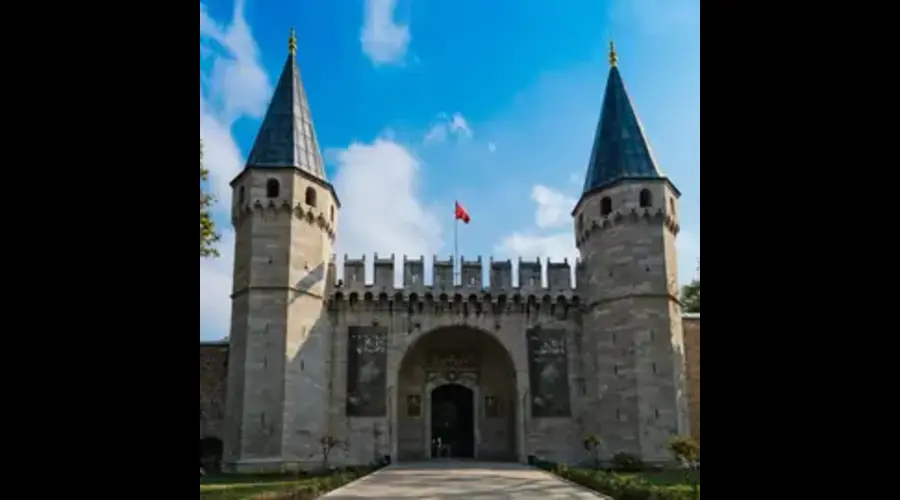Nestled in the heart of Istanbul, overlooking the sparkling waters of the Bosphorus, the Topkapi Palace is one of Turkey’s most iconic and captivating landmarks. Once the grand residence of Ottoman sultans for almost 400 years, this palace is now a mesmerizing museum that offers a glimpse into the opulence, power, and cultural richness of one of the world’s most influential empires. With its stunning architecture, rich history, and breathtaking collections, Topkapi Palace is a must-visit destination for anyone traveling to Istanbul.
A Brief History of Topkapi Palace
Construction of Topkapi Palace began in 1459, just a few years after the Ottoman conquest of Constantinople (modern-day Istanbul) by Sultan Mehmed II, known as Mehmed the Conqueror. The palace was designed to serve as both the political center and the royal residence of the sultans, as well as a symbolic representation of the Ottoman Empire’s might and grandeur.
Topkapi Palace remained the heart of the empire until the mid-19th century when Sultan Abdulmecid I moved the imperial court to Dolmabahçe Palace, a more modern and European-style residence. After the fall of the Ottoman Empire and the establishment of the Republic of Turkey in 1923, Topkapi Palace was converted into a museum, allowing the public to explore its historic rooms, halls, and gardens.
Architectural Beauty and Layout
Topkapi Palace is not a single building but rather a sprawling complex of courtyards, gardens, and buildings. Its design reflects the traditional Ottoman architectural style, with intricate tile work, elaborate domes, and serene courtyards. The palace is divided into several main sections:
1. The First Courtyard (Outer Courtyard)
The First Courtyard, also known as the “Gate of Salutation,” is the entryway to the palace. This large open space was once home to the palace’s outer administrative functions and was used as a public area. Visitors enter through the Imperial Gate, where they are greeted by the stunning sight of lush gardens and fountains. The First Courtyard also houses the Sultan’s Gate and several important buildings, including the Aya Sofya Gate, leading visitors towards the palace’s more private and sacred sections.
2. The Second Courtyard (Divan Courtyard)
As you pass into the Second Courtyard, you are entering a more private and restricted area, historically reserved for the sultan and his inner circle. This courtyard is home to the Divan-i-Humayun, the Imperial Council Hall, where the sultan would meet with his viziers and military commanders to discuss state affairs. The architecture here is exquisite, with a series of intricately tiled columns and a beautiful fountain at the center.
Also within the Second Courtyard is the Palace Kitchen, which is home to one of the most impressive displays of Ottoman culinary history. The kitchens were once used to prepare elaborate meals for the sultan and his court, and today they house an extensive collection of Ottoman-era ceramics, silverware, and cooking utensils.
3. The Third Courtyard (The Harem and Imperial Residence)
The Third Courtyard is where the private life of the sultan and his family was lived out. This section of the palace houses the Harem, the most secretive and mysterious part of Topkapi Palace. The Harem was the private quarters of the sultan’s wives, concubines, and children. It is an area that remains a subject of fascination due to its complex social dynamics and intrigue.
Visitors to the Harem will be awed by the stunning architecture, from the ornate rooms and courtyards to the intricately painted ceilings. The Sultan’s Apartments and Concubine’s Rooms are filled with magnificent furnishings, delicate tilework, and rare artifacts that give insight into the opulent lifestyle of the royal family.
4. The Fourth Courtyard (The Sultan’s Garden)
The Fourth Courtyard is a peaceful garden filled with lush greenery, exotic flowers, and tranquil fountains. It was designed to provide a serene retreat for the sultan and his family. The Library of Ahmed III is also located here, an architectural masterpiece with beautiful woodwork, calligraphy, and a collection of ancient manuscripts and books.
Notable Exhibits and Artifacts
Topkapi Palace is renowned for its incredible collection of artifacts, many of which were once used by the royal family or were acquired during the Ottoman Empire’s military conquests. Some of the most famous pieces on display include:
- The Topkapi Dagger: This ornate dagger, famously featured in the movie Topkapi, is encrusted with jewels and dates back to the 16th century. It’s one of the most famous pieces of Ottoman weaponry and is an exceptional example of Ottoman craftsmanship.
- The Sacred Relics: Among the most revered collections are the sacred Islamic relics, including pieces believed to have once belonged to the Prophet Muhammad. The Sword of the Prophet and his Mantle are on display in the Sacred Relics Chamber, an area that draws visitors from around the world.
- Imperial Treasures: The palace is home to an extensive collection of jewelry, including the famous Kaftans and Jewels of the Sultans, which demonstrate the empire’s vast wealth and the fine craftsmanship of Ottoman artisans. The Sapphire of the Sultan is another dazzling example of the imperial treasures.
- Ottoman Miniatures: The palace houses many beautifully crafted miniatures, illustrating historical events, royal life, and religious scenes. These tiny works of art were often used in Ottoman books of history, poetry, and scientific manuscripts.
A Visit to the Palace Today
Today, Topkapi Palace is one of Istanbul’s most popular tourist attractions, drawing millions of visitors each year. Its status as a UNESCO World Heritage site makes it a vital part of the cultural heritage of Turkey. The museum offers guided tours in multiple languages and is well-equipped with modern amenities to ensure a comfortable experience for visitors.
It’s easy to lose yourself for hours exploring the vast courtyards, rooms, and galleries, each telling the story of the Ottoman Empire’s power, wealth, and cultural influence. Be sure to take some time to relax in the palace’s gardens, which offer stunning views of the Bosphorus Strait and the Golden Horn, providing a perfect opportunity to reflect on the grandeur of this historical gem.
Conclusion
Topkapi Palace is a timeless testament to the splendor of the Ottoman Empire. With its remarkable architecture, luxurious interiors, and unparalleled collection of artifacts, it offers a fascinating window into a bygone era of opulence, politics, and intrigue. Whether you’re a history buff, an art lover, or just looking for a stunning cultural experience, a visit to Topkapi Palace is sure to be an unforgettable journey through the heart of Istanbul’s imperial past.




